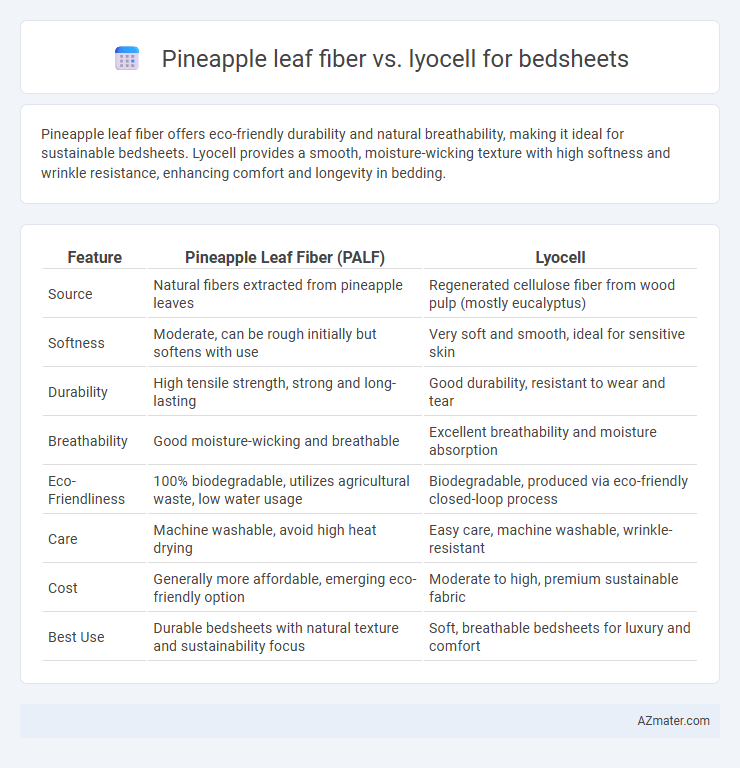Pineapple leaf fiber offers eco-friendly durability and natural breathability, making it ideal for sustainable bedsheets. Lyocell provides a smooth, moisture-wicking texture with high softness and wrinkle resistance, enhancing comfort and longevity in bedding.
Table of Comparison
| Feature | Pineapple Leaf Fiber (PALF) | Lyocell |
|---|---|---|
| Source | Natural fibers extracted from pineapple leaves | Regenerated cellulose fiber from wood pulp (mostly eucalyptus) |
| Softness | Moderate, can be rough initially but softens with use | Very soft and smooth, ideal for sensitive skin |
| Durability | High tensile strength, strong and long-lasting | Good durability, resistant to wear and tear |
| Breathability | Good moisture-wicking and breathable | Excellent breathability and moisture absorption |
| Eco-Friendliness | 100% biodegradable, utilizes agricultural waste, low water usage | Biodegradable, produced via eco-friendly closed-loop process |
| Care | Machine washable, avoid high heat drying | Easy care, machine washable, wrinkle-resistant |
| Cost | Generally more affordable, emerging eco-friendly option | Moderate to high, premium sustainable fabric |
| Best Use | Durable bedsheets with natural texture and sustainability focus | Soft, breathable bedsheets for luxury and comfort |
Introduction to Sustainable Bedsheet Fabrics
Pineapple leaf fiber and lyocell are two sustainable materials gaining popularity in eco-friendly bedsheets due to their renewable sources and biodegradable properties. Pineapple leaf fiber, derived from agricultural waste, boasts high durability and moisture-wicking capabilities, making it ideal for long-lasting, breathable bedding. Lyocell, produced from sustainably harvested wood pulp using an environmentally friendly solvent-spinning process, offers exceptional softness and strength while minimizing chemical and water usage.
Overview of Pineapple Leaf Fiber
Pineapple leaf fiber, derived from the long leaves of pineapple plants, is a sustainable and biodegradable material known for its natural strength, breathability, and moisture-wicking properties, making it ideal for eco-friendly bedsheets. Unlike Lyocell, which is a regenerated cellulose fiber produced through a solvent-spinning process from wood pulp primarily sourced from eucalyptus, pineapple leaf fiber offers a more natural texture and enhanced durability due to its coarse, fibrous structure. The cultivation of pineapple leaves for fiber extraction also reduces agricultural waste, presenting a greener alternative to Lyocell that relies on intensive chemical processing.
What is Lyocell?
Lyocell is a sustainable fabric made from wood pulp, primarily eucalyptus trees, processed through a closed-loop system that recycles water and solvents, minimizing environmental impact. It is known for its softness, breathability, and moisture-wicking properties, making it ideal for bedsheets that require durability and comfort. Compared to pineapple leaf fiber, Lyocell offers a smoother texture and better moisture management, enhancing sleep quality while supporting eco-friendly textile production.
Environmental Impact: Pineapple Leaf Fiber vs Lyocell
Pineapple leaf fiber is a highly sustainable option for bedsheets, as it is derived from agricultural waste, reducing landfill burden and water consumption during production. Lyocell, made from sustainably sourced wood pulp using a closed-loop process, minimizes chemical waste and has a lower carbon footprint compared to conventional fibers. Both fibers offer eco-friendly alternatives, but pineapple leaf fiber excels in waste utilization while lyocell leads in water efficiency and chemical management.
Softness and Comfort Comparison
Pineapple leaf fiber bedsheets offer a unique texture that is durable yet less soft compared to Lyocell, which is renowned for its exceptional smoothness and silky feel. Lyocell excels in moisture-wicking and breathability, providing superior comfort for sensitive skin, while pineapple leaf fiber tends to be coarser but highly breathable and eco-friendly. For optimal softness and comfort, Lyocell remains the preferred choice, especially in luxury bedding, whereas pineapple leaf fiber suits eco-conscious consumers seeking sustainability with moderate softness.
Durability and Longevity
Pineapple leaf fiber exhibits exceptional durability and longevity due to its strong cellulose content and natural resilience, making it resistant to wear and tear over time. Lyocell, derived from wood pulp through a closed-loop process, offers impressive strength and softness but generally has a slightly shorter lifespan compared to pineapple leaf fiber. For bedsheets, pineapple leaf fiber ensures extended use with maintained integrity, while lyocell provides comfortable softness with moderate durability.
Moisture-Wicking and Breathability
Pineapple leaf fiber offers superior moisture-wicking properties due to its natural hydrophilic structure, effectively drawing sweat away from the skin to keep sleepers dry. Lyocell, made from sustainably sourced wood pulp, excels in breathability with a smooth, porous surface that enhances airflow and temperature regulation. Both materials provide excellent comfort for bedsheets, but pineapple leaf fiber is favored for intense moisture absorption, while lyocell is prized for balanced ventilation and softness.
Allergen-Friendly Properties
Pineapple leaf fiber offers natural hypoallergenic properties due to its antimicrobial and anti-fungal characteristics, making it an excellent choice for allergy-sensitive individuals. Lyocell is also known for its allergen-friendly traits as it resists dust mites and mold while providing a smooth, breathable surface that reduces skin irritation. Both fibers contribute to a healthier sleeping environment, but pineapple leaf fiber stands out for its enhanced natural resistance to common allergens.
Cost and Market Availability
Pineapple leaf fiber offers a cost-effective alternative for bedsheets, often priced lower due to its natural abundance and minimal processing requirements compared to Lyocell, which involves more complex, environmentally friendly manufacturing. Lyocell bedsheets dominate the market with widespread availability from major textile brands, benefiting from established supply chains and strong eco-conscious consumer demand. Pineapple leaf fiber remains niche but growing, primarily accessible in regions where pineapple agriculture thrives and sustainable textile innovation is prominent.
Which is Better for Eco-Friendly Bedding?
Pineapple leaf fiber and Lyocell both offer sustainable options for eco-friendly bedding, but Pineapple leaf fiber stands out for its natural biodegradability and minimal water usage in cultivation. Lyocell, made from sustainably sourced wood pulp, provides a softer texture and superior moisture-wicking properties, enhancing comfort and durability. Choosing the better option depends on prioritizing either environmental conservation through low-impact agriculture (pineapple leaf fiber) or softness combined with responsible forestry practices (Lyocell).

Infographic: Pineapple leaf fiber vs Lyocell for Bedsheet
 azmater.com
azmater.com